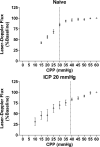Continuous measurement of autoregulation by spontaneous fluctuations in cerebral perfusion pressure: comparison of 3 methods
- PMID: 18669896
- PMCID: PMC2566962
- DOI: 10.1161/STROKEAHA.108.514877
Continuous measurement of autoregulation by spontaneous fluctuations in cerebral perfusion pressure: comparison of 3 methods
Abstract
Background and purpose: Clinical application of continuous autoregulation monitoring would benefit from a comparison of curves generated by online monitoring with standard autoregulation curves in animal models. We characterized the accuracy of 3 continuous monitors of autoregulation in a piglet model of hypotension.
Methods: Piglets 5 to10 days old with intracranial pressure (ICP) at naïve or elevated (20 mm Hg) levels had gradual arterial hypotension induced by a balloon catheter in the inferior vena cava. Elevated ICP was maintained by a continuous infusion of artificial cerebrospinal fluid. Three indices of autoregulation were simultaneously and continuously calculated. A moving, linear Pearson's coefficient between spontaneous slow waves of cerebral perfusion pressure and slow waves of laser-Doppler flux or cortical oxygenation rendered the laser-Doppler index and cerebral-oximetry index, respectively. Similar correlation between slow waves of arterial blood pressure and ICP rendered the pressure-reactivity index. The lower limit of autoregulation was determined directly for each animal by plotting laser-Doppler cortical red blood cell flux as a function of cerebral perfusion pressure. Receiver-operator characteristics were determined for the 3 indices.
Results: The areas under the receiver-operator characteristics curves for discriminating the individual lower limit of autoregulation at low and high ICP were 0.89 and 0.85 for the laser-Doppler index, 0.89 and 0.84 for the cerebral-oximetry index, and 0.79 and 0.79 for the pressure-reactivity index. The pressure-reactivity index performed equally well at low and high ICPs.
Conclusions: Continuous monitoring of autoregulation by spontaneous slow waves of cerebral perfusion pressure can accurately detect loss of autoregulation due to hypotension in piglets by all 3 modalities.
Figures




References
-
- Mazzola CA, Adelson PD. Critical care management of head trauma in children. Crit Care Med. 2002;30(suppl):S393–S401. - PubMed
-
- Steiner LA, Czosnyka M, Piechnik SK, Smielewski P, Chatfield D, Menon DK, Pickard JD. Continuous monitoring of cerebrovascular pressure reactivity allows determination of optimal cerebral perfusion pressure in patients with traumatic brain injury. Crit Care Med. 2002;30:733–738. - PubMed
-
- Brain Trauma Foundation, American Association of Neurological Surgeons, Congress of Neurological Surgeons, Joint Section on Neuro-trauma and Critical Care, AANS/CNS Guidelines for the management of severe traumatic brain injury, IX: cerebral perfusion thresholds. J Neurotrauma. 2007;24(suppl 1):S59–S64. - PubMed
-
- Czosnyka M, Smielewski P, Kirkpatrick P, Menon DK, Pickard JD. Monitoring of cerebral autoregulation in head-injured patients. Stroke. 1996;27:1829–1834. - PubMed
-
- Czosnyka M, Smielewski P, Kirkpatrick P, Laing RJ, Menon D, Pickard JD. Continuous assessment of the cerebral vasomotor reactivity in head injury. Neurosurgery. 1997;41:11–17. discussion 17−19. - PubMed
Publication types
MeSH terms
Grants and funding
LinkOut - more resources
Full Text Sources
Other Literature Sources

